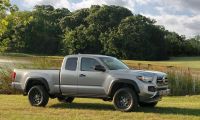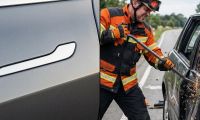During the last week, Ford and the other major U.S. automakers have stepped up and offered to help with the crisis in medical equipment that has exploded as a result of the coronavirus pandemic. Jimmy Dismore discusses Ford's commitment to making needed medical equipment.
Ford Team Congratulated For Work Today
Most people congratulated the auto industry for its commitment to help. Indeed, a group of Ford engineers has come up with a plastic face shield that is helping to protect members of emergency medical teams battling on the front lines of the coronavirus fight. My colleague Mary Conway discusses FCA's plan to help the medical emergency. Torque News Senior Correspondent John Goreham writes about Tesla's successful medical crisis assistance plan.
Today's work isn't the first time that Ford engineers have jumped into a medical crisis. About 72 years ago, at the height of another medical pandemic, a Ford engineering team also stepped up to help kids breathe.
The pandemic we are talking about is the polio outbreak of the late 1940s and early 1950s when it seemed there was no cure this particularly nasty scourge.
Ford Team Helps To Fight Polio
Left, right, and center, it seemed as if kids were coming down with the poliomyelitis germ, a germ that attacked the muscle and nerve systems. The bug took away the ability of kids to walk, use their arms, and, in many cases, breathe normally.
Polio was the disease that the germ caused. From about 1940 to 1955, worried parents watched their kids for signs of the disease, the significant weaknesses, and tremors. It seemed to be a disease of warm weather. Every summer, parents shipped their kids to open-air camps so they would, many parents thought, avoid polio.
Somehow, many parents assumed that if their kids received fresh air, especially if they lived in a city, they would avoid polio. They did not suspect that the germs would follow their children and cruelly inflict their kids, even at summer camp.
One of polio's significant impacts occurred when it attacked the back and spine. Suddenly, kids had trouble breathing. At the time, the only way to keep them alive was huge iron lungs, into which they were inserted, often for good, so they could continue to breathe.
Ford Team Helps Fight Breathing Machine Shortage
Like today, there was a shortage of this vital breathing equipment. Here's where the Ford team enters the picture. They made an iron lung for kids from 7 to 12 that enabled them to breathe.
The Ford team worked in the Plastics building of the Rouge assembly site. According to a newspaper article from the time, the Plastics team was responsible for most of the work on the iron lung.
"Since most of the iron lung is made of rubber and plexiglass, the Plastics plant has done the major portion of the work," a newspaper clipping from Oct. 23, 1948, said.
An engineer named Jess Blaha did a significant portion of the design work on the iron lung. At this point, members of the "rubber job employees" picked up the work on the device, the newspaper acknowledged.
Ford Team Picks Up Major Portions Of Work
Why did they pick up the job? As the newspaper clipping explained, much of the iron lung major construction consisted of rubber and plexiglass, so it was a no-brainer.
"Rubber parts and the plexiglass body comprise more than half of the iron lung. A metal frame, made by the Tool and Die building employees, supports it. The lung was assembled in the Plastics plant," the newspaper clipping said.
What is surprising, when you first look at the article, is the speed with which the Ford employee team worked. They built the iron lung in ten days.
With all of the essential parts made and assembled, the rubber operations team completed all the miscellaneous parts, including the rolls for the "Glass Plant, sand-blast for the Production Foundry, gaskets, and relining for various type accident, plating, and pickling tanks."
Ford Team Members Who Led Work
The production workers given credit for much of the work, were William Campbell, Lee McDermott, Clifford H. Bennett, "supervisor of the rubber job."
Though not stated, the article used as the basis for this piece likely appeared in the Detroit News or Detroit Free Press for Oct. 23, 1948. It shows the depth of commitment of Ford engineers and their ingenuity.
Today, there are few iron lungs out there still in use, and those that are out there are wearing out. They did their work through the darkest days of the polio epidemic, keeping their human cargo alive.
The beginning of the end of the necessity for iron lungs was due to the welcome research work of Dr. Jonas Salk and his scientific team. They came out with the first anti-polio vaccine in 1955. Dr. Salk and company began the eradication of that particular childhood malady.
Marc Stern has been an auto writer since 1971. It was a position that filled two boyhood dreams: One was that I would write, and two that I write about cars. When I took over as my newspaper's auto editor, I began a 32-year career as an automotive columnist. There isn't much on four wheels that I haven't driven or reviewed. My work has appeared in Popular Mechanics, Mechanix Illustrated, AutoWeek, SuperStock, Trailer Life, Old Cars Weekly, Special Interest Autos, and others. Today, I am the Ford F150 reporter for Torque News. I write how-to and help columns for online sites such as Fixya.com and others. You can follow me on Twitter or Facebook. Most of Marc's stories can be found at Torque News Ford coverage. Check back again and search for Torque News Ford F-150 news for more F-150 truck news coverage.












